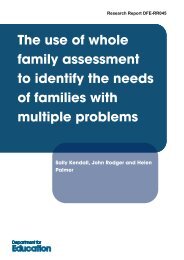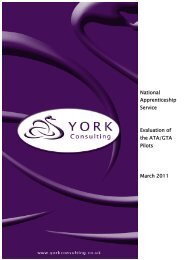Recruitment and Retention in the Post-16 Learning and Skills Sector
Recruitment and Retention in the Post-16 Learning and Skills Sector
Recruitment and Retention in the Post-16 Learning and Skills Sector
Create successful ePaper yourself
Turn your PDF publications into a flip-book with our unique Google optimized e-Paper software.
• “I met one of <strong>the</strong> managers at a toy library, <strong>and</strong> <strong>the</strong>y encouragedme to apply” [Adult <strong>and</strong> Community Learn<strong>in</strong>g].Summary3.32 Key po<strong>in</strong>ts aris<strong>in</strong>g from <strong>the</strong> research relat<strong>in</strong>g to <strong>in</strong>dividuals motivation tojo<strong>in</strong> <strong>the</strong> sector are as follows:• <strong>the</strong> majority of staff (61%) started work<strong>in</strong>g <strong>in</strong> <strong>the</strong> sector between <strong>the</strong>ages of 18 <strong>and</strong> 34;• most entrants did not beg<strong>in</strong> <strong>the</strong>ir career with a clear ambition to go<strong>in</strong>to teach<strong>in</strong>g/tra<strong>in</strong><strong>in</strong>g <strong>in</strong> <strong>the</strong> post-<strong>16</strong> sector. The majority of staffentered <strong>the</strong> sector after work<strong>in</strong>g <strong>in</strong> o<strong>the</strong>r <strong>in</strong>dustry sectors – smallernumbers entered from teach<strong>in</strong>g or with no previous experience;• entrants from <strong>in</strong>dustry were most likely to go <strong>in</strong>to work basedlearn<strong>in</strong>g or adult <strong>and</strong> community learn<strong>in</strong>g provision. Many left<strong>in</strong>dustry due to stress or a desire to do someth<strong>in</strong>g ‘moreworthwhile’;• only a small number of respondents jo<strong>in</strong>ed <strong>the</strong> sector early <strong>in</strong> <strong>the</strong>ircareer after qualify<strong>in</strong>g as a teacher via <strong>the</strong> PGCE route. Fewplanned to jo<strong>in</strong> <strong>the</strong> sector <strong>and</strong> most ‘discovered’ <strong>the</strong> sector througha variety of means;• <strong>the</strong> common reasons for leav<strong>in</strong>g <strong>the</strong> school sector <strong>in</strong>cluded betterdiscipl<strong>in</strong>e <strong>and</strong> learner motivation;• nearly half of respondents (46%) <strong>in</strong>dicated some vocationalreasons for jo<strong>in</strong><strong>in</strong>g <strong>the</strong> sector, this was followed by just over a thirdof respondents (35%) who <strong>in</strong>dicated personal reasons. Thebiggest s<strong>in</strong>gle reason for jo<strong>in</strong><strong>in</strong>g <strong>the</strong> sector was to help people todevelop (26% of respondents), closely followed by those whowanted to change <strong>the</strong>ir career path (19%);• a specific personal reason relat<strong>in</strong>g to women with families is <strong>the</strong>attraction of <strong>the</strong> sector’s comparative flexibility, particularly,compared with school teach<strong>in</strong>g;• for a m<strong>in</strong>ority of staff work<strong>in</strong>g <strong>in</strong> <strong>the</strong> sector a major <strong>in</strong>fluenc<strong>in</strong>gfactor was personal or family l<strong>in</strong>ks to education or <strong>in</strong>spiration by agood teacher/tra<strong>in</strong>er.30











